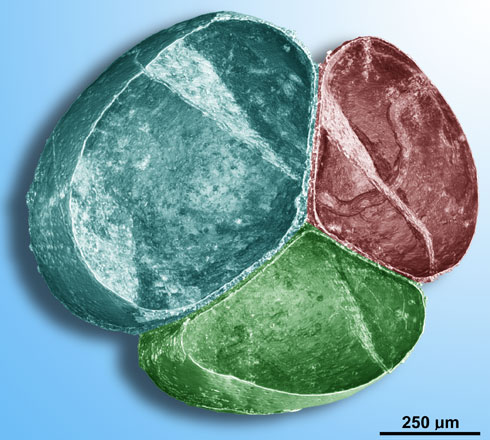- Home
- News
- Spotlight on Science
- Looking inside fossilised...
Looking inside fossilised embryos
13-11-2006
Microtomography was used to study fossilised embryos from China. The results suggest that complex embryonic development existed thousands of years earlier than previously believed.
Share
Evidence of the first animals on Earth goes back to 700 million years. However, to date, the origin of complex animals with symmetry in a central plane (bilaterian) has remained a point of speculation. A team of researchers from China, the USA and France have found evidence of complex embryonic development, equivalent to that of some modern bilateralians, that already existed 580 million years ago. This is 40 million years earlier than previously thought. The scientists came to ESRF beamline ID19 to investigate the internal structures of these fossilised embryos from Southwest China in a non-destructive manner. They found a striking resemblance between the cellular cleavage pattern in the fossil embryos and that of modern polar lobe-forming embryos. These results were published in the journal Science in June.
Polar lobe is a structure observed in many molluscs and some annelids. It is a symmetry-breaking process that occurs at the early embryonic development stage associated with embryonic cells of unequal sizes. This process leads to particular embryonic structures that were identified on fossils from 580 million years old phosphate deposits.
The beginning of the Cambrian period (540 million years ago) is known as the Cambrian explosion since most of the major groups of animals appear suddenly in the fossil record from that period. This new breakthrough implies that the complex lobe-forming embryonic development already existed much earlier than previously thought.
The team examined the samples taken from the Precambrian rocks in Weng’an, China, using microtomography. Thanks to the 3D data collected on the ID19 beamline, they succeeded in revealing the typical internal structures linked to the polar lobe formation process, which validated the interpretation of these fossils. Taking into account the size of the samples (between 250 and 500 micrometres) and their mineralisation pattern, only microtomography with sub-micrometric resolution and phase contrast was able to reveal the internal structures in sufficient detail to show their 3D organisation.
Following on from these results, the team will be studying fossils from Precambrian rocks that may present a different structure with the aim of finding out more about the history of living beings.
Principal Publication and Authors
J-Y. Chen (a), D.J. Bottjer (b), E.H. Davidson (c), S.Q. Dornbos (d), X. Gao (a), Y-H. Yang (a), C-W. Li (e), G. Li (f), X-Q. Wang (a), D-C. Xian (f), H-J. Wu (e), Y-K. Hwu (g), P. Tafforeau (h, i), Phosphatized Polar Lobe-Forming Embryos from the Precambrian of Southwest China, Science 312, 1644-1646 (2006).
(a) Nanjing Institute of Geology and Paleontology, Nanjing University (China)
(b) University of Southern California (USA)
(c) California Institute of Technology, Pasadena (USA)
(d) University of Wisconsin, Milwaukee (USA)
(e) National Tsing Hua University, Taiwan (China)
(f) Institute of High Energy Physics, Beijing (China)
(g) Institute of Physics, Academia Sinica, Taipei, Taiwan (China)
(h) UMR CNRS 6046, Poitiers (France)
(i) ESRF




